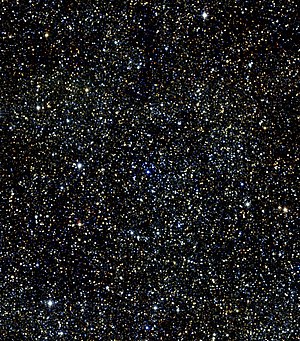Messier 21

|
|
| Messier 21 Atlas Image courtesy of 2MASS / UMass / IPAC-Caltech / NASA / NSF |
|
| AladinLite | |
| Constellation | Sagittarius |
|
Position equinox : J2000.0 |
|
|---|---|
| Right ascension | 18 h 04 m 13 s |
| declination | −22 ° 29 ′ 24 ″ |
| Appearance
|
|
| classification | I, 3, m (Trumpler), d (Shapley) |
| Brightness (visual) | 5.9 likes |
| Brightness (B-band) | 6.02 mag |
| Angular expansion | 13 ' |
| Number of stars | 57 |
| Physical data
|
|
| Redshift | −49 · 10 −6 |
| Radial velocity | −14.71 km / s |
| distance | 4250 ly (1300 pc ) |
| diameter | 16 years |
| Age | 4.6 million years |
| history | |
| Discovered by | Charles Messier |
| Discovery time | June 5, 1764 |
| Catalog names | |
| M 21 • NGC 6531 • C 1801-225 • OCl 26 • Mel 188 • Cr 363 • Lund 806 • ESO 521-SC019 • OCISM 3 | |
Messier 21 (also known as NGC 6531 ) is a +5.9 mag bright open star cluster with an area of 13 'in the constellation Sagittarius . M21 is not easily observed in Central Europe because of its southern position.
See also: Messier catalog
Web links
Commons : Messier 21 - album with pictures, videos and audio files

